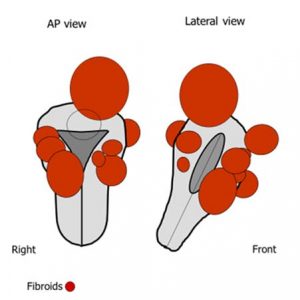Heavy periods
Uterine fibroids
Uterine fibroids are the commonest abnormality of the uterus. The location of fibroids is more important than their size. Even very small fibroids pressing on the lining of the womb can cause very heavy periods, whilst very large fibroids bulging outside the womb may cause no symptoms at all. In view of that it is very important to describe the location of fibroids accurately on ultrasound scan.
 This is known as fibroid mapping and it can be done using a combination of 2D and 3D ultrasound. This information can be used not only to determine whether the fibroids are the likely cause of women’s symptoms, but also to decide what type of treatment could be offered to women suffering with these periods
This is known as fibroid mapping and it can be done using a combination of 2D and 3D ultrasound. This information can be used not only to determine whether the fibroids are the likely cause of women’s symptoms, but also to decide what type of treatment could be offered to women suffering with these periods
Adenomyosis
Adenomyosis is a common condition that is found in the muscle layer of the uterus and is known to cause heavy and painful periods. Using ultrasound, we can not only diagnose adenomyosis, but also see how severe it is, which correlates with the menstrual loss. This helps us determine how likely the adenomyosis is to be the cause of menstrual symptoms which helps to guide management.